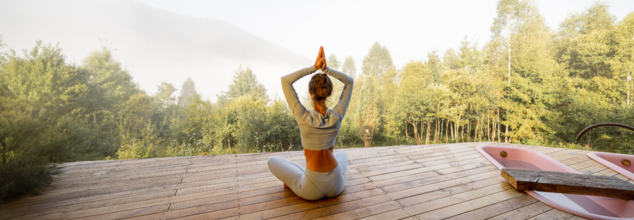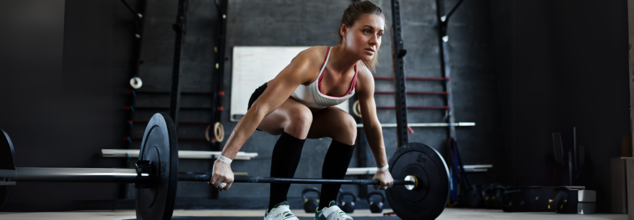
(Credit-Canva)
10 Minutes, Daily, Every Week: 8 Yoga Poses To Stay Fit And Healthy
Yoga has the ability to set the tone of your day. We see people who wake up super early, do a morning routine and squeeze in some yoga. This may seem like a hectic schedule to many, but exercising early in the morning has shown to be good for the mental as well as physical well-being of people. Experts explain that doing yoga every morning increases your energy, improves mental clarity, helps you reduce stress as well as ensure your physical well-being.
If you are worried about spending a dedicated time doing yoga, like an hour or so, you do not have to worry. Even spending 10 minutes, fully focused yoga can help you immensely. If you are doing these poses with guided videos, make sure you are not pushing yourself too hard, and proceed with caution. If you feel any odd discomfort, make sure you visit a healthcare professional just to be safe.
Child's Pose
Begin in Child's Pose, bringing your big toes together and knees wide for a comfortable stretch. Extend your arms forward, lifting onto your fingertips to deepen the stretch in your shoulders and armpits. Focus on expanding your ribcage with each inhale and relaxing your arms closer to the mat with each exhale, using your breath to settle into the pose.
Cat-Cow
Transition to Tabletop position, bringing your knees closer together. Flow through three rounds of Cat-Cow, arching your back on the inhale and rounding it on the exhale. This movement helps to gently mobilize and warm up your spine.
Leg Lifts and Variations
From Tabletop, lift your right leg, knee, and toes towards the ceiling on the inhale, and bring your knee to your nose on the exhale. Repeat twice, engaging your core. For an added challenge, lift your right leg again and reach back with your left hand to grab your right foot, deepening the backbend and stretching your left shoulder.
Modified Side Plank
With your right leg lifted, return your left hand to the mat, straighten your right leg, and roll onto the inner edge of your right foot into a modified Side Plank. Perform five toe taps, lifting and lowering your right leg, then bend your right knee to grab your right foot, deepening the backbend and shoulder stretch. Repeat the sequence on the left side.
Downward-Facing Dog
Move into Downward-Facing Dog, lifting your hips up and back, bending your knees as needed to lengthen your spine. From Down Dog, lift your right leg, bend your knee, and open your hip in Scorpion Dog.
Warrior 2 and Triangle Pose
Step your right foot forward into Warrior 2, grounding through your back foot and bending your front knee. Transition into Triangle Pose, straightening your right leg and reaching your right arm forward, then down, while your left arm extends upward. Explore variations to deepen the pose and strengthen your obliques.
Low Lunge and Quad Stretch
From Triangle Pose, move into Low Lunge, placing your back knee on the mat. Optionally, add a quad stretch by reaching back with your right hand to grab your left foot, pulling your heel towards your glutes. Repeat the sequence on the left side, then move back to Downward-Facing Dog.
Child's Pose and Seated Meditation
Return to Child's Pose, resting your hips towards your heels and extending your arms forward. Take five deep breaths, reflecting on your intention for the day. Transition into a comfortable seated position for a short meditation. Close your eyes, relax your shoulders, and soften your facial muscles. Focus on your breath and your intention for the day, grounding yourself before moving forward.

Credits: Canva
This 15-Minute Workout 3 Times A Week Can Make Look 8 Years Younger
Aging gracefully is something we all want, but what if science said it told you that you don't just have to look and feel younger based on skincare or supplements—but maybe actually starts in the weight room? A new study out in the journal Biology shows that doing a mere 15 minutes of strength training, three times a week, can make your biological age drop up to 8 years.
While exercise has been widely championed for keeping us healthy and robust, this new study illuminates its underlying impact on cellular aging, presenting a strong argument for adding short, intense workouts to your routine.
Carried out on almost 4,900 American adults, the research investigated the connection between strength training and telomere length—those little protective caps on our chromosomes that naturally get shorter as we get older. Telomeres are one of the most precise indicators of biological age. The shorter they are, the older your body feels and acts.
Scientists discovered that those who took part in frequent strength training had much longer telomeres, independent of considerations like age, sex, race, income, smoking status, body size, or other physical activity levels.
Here's what was surprising:
- Each 10 minutes of strength training per week was linked with slightly longer telomeres.
- Those who worked out 90 minutes of strength training per week had biological ages almost 4 years younger.
- Those who trained for 180 minutes per week experienced a decrease equivalent to 8 years of biological aging.
The moral? Only 45 minutes of strength training over three days a week can reverse your body's clock.
How Strength Training Affects Biological Age?
The benefits of strength training extend far beyond defined arms and better posture. On a cellular level, this type of exercise actually works to repair and rebuild your body. Researchers say resistance exercises can even slow the aging process by:
- Lowering risks for chronic disease (such as diabetes and heart disease)
- Increasing resting metabolic rate
- Encouraging fat loss and muscle gains
- Enhancing cardiovascular function and insulin sensitivity
- Increasing overall strength and mood stability
As muscle mass loses strength with age—a phenomenon termed sarcopenia—strength training acts as an antidote, postponing or mitigating the process.
Why 15 Minutes Can Have Such a Difference?
You don't require prolonged visits to the gym or elaborate apparatus to enjoy the benefits. The study highlights consistency as superior to intensity or frequency. Three visits per week to the gym of 15-minute duration can tally up to radically different results, provided muscle stimulation and technique are the areas of focus.
This leaves the door open for working professionals, parents, and seniors to gain benefits without radically changing their routines. The message is straightforward: a little does a lot.
Current Physical Activity Guidelines: Are You Doing Enough?
The Physical Activity Guidelines for Americans suggest:
- A minimum of 150 minutes of moderate-intensity aerobic physical activity per week
- Two or more days a week of muscle-strengthening activities
This study not only confirms those suggestions but stresses that strength training, even in brief intervals, is a key factor in cellular youthfulness and disease prevention.
Ways to Fit in 15 Minutes of Strength Training Daily
You don't have to go to a gym to turn back your biological clock. Here are realistic ways to incorporate strength training into your daily routine:
- Bodyweight exercises: Squats, push-ups, lunges, and planks
- Resistance bands: Inexpensive and portable
- Home dumbbell sets: Compound movements such as rows and shoulder presses
- Step-ups or stair climbing: Leg strength with a boost of cardio
- Pilates or barre class: Core strengthening and increased flexibility
- Guided online workouts: Utilize free or paid platforms for formatted 15-minute sessions
- Mini circuits: Alternate 3–4 strength exercises with brief rest periods
This research contributes to the mounting evidence that aging isn't all about genetics—it's about lifestyle. Small, regular habits such as strength training for only 15 minutes a day can do more than make you look fit—they can actually make your cells feel younger.
So whether you're 30, 50, or beyond, now's the time to grab a resistance band, drop into a squat, or lift a weight—and start turning back the clock. By doing just 45 minutes of strength training a week, you're not only changing your body, you're updating your body's inner blueprint. And that's an investment in fitness worth making.

(Credit-Canva)
Explainer: Why Do Heavy Lifters Use Smelling Salts Before Big Lifts?
Videos of heavy lifters often go viral on social media; the sheer power and endurance is not something people can achieve easily. One thing that a lot of them do before they proceed with the lift is smell something and immediately go in for the lift. Those are smelling salts. Smelling salts are products that have a strong ammonia smell and have been used to wake people up after they faint. Lately, some athletes have become interested in using them to feel more alert and perform better. However, do they actually work? Another thing to consider is how something that has such an immediate effect on a person can be safe.
How do Smelling Salts Affect Someone?
According to the National Capital Poison Centre the ammonia that these salts contain has a pungent smell that can cause irritation to the lungs. It can also lead to changes in the breathing patterns. This change in breathing causes people who have fainted to become conscious. These have been present since the 13th century to treat lightheadedness and fainting. The strong odor temporarily increases the heart rate of a person and blood flows to the brain. These symptoms remain for about 15 seconds after inhalation and then subside withing a minute or so. So why do lifters use it when they are fully conscious and do not need to be more alert?
Why Do Gym-Lifters Use Smelling Salts?
Athletes commonly use smelling salts to get a quick boost before or during competitions, hoping it will give them more energy, make them more alert, and speed up their reactions. Unlike many other stimulant drugs, the ammonia in smelling salts is allowed by the World Anti-Doping Agency. You'll often see powerlifters using them, especially right before their final lift, the deadlift. The International Powerlifting Federation even lets athletes inhale ammonia as long as they do it privately. However, even though athletes might feel like smelling salt improves their performance but there is no evidence of it. According to a British Journal of Sports Medicine 2006 article, there's no real proof that they actually make them stronger or more powerful. In the past, smelling salts were sometimes used to treat athletes with minor head injuries, but they probably didn't actually help in those situations.
Smelling Salts Can Go Badly For Anyone
Smelling salts haven't been studied well for use as performance-enhancing supplements, and they aren't approved by the government as stimulant drugs.
The US Food and Drug Association has even warned people about using certain smelling salts that were being advertised to make people more alert and give them energy, even though they hadn't been approved for these uses. They had also received reports of people having problems like shortness of breath, seizures, migraines, vomiting, diarrhea, and fainting after using these products.
National Capital Poison Control provided an example of a female powerlifter who had used smelling salts right before competing. After inhaling, she developed severe symptoms like a runny nose, eye redness, dizziness and a headache. These symptoms got worse over the hour leaving her gasping for air. It was later diagnosed that she was allergic to smelling salts and was treated as such.
Note: If you are thinking about using smelling salts, it's best to talk to a doctor first to see if they are right for you. They can also tell you how often you can use them, if at all, and which products might be best. Keep in mind that smelling salts are not a good idea for everyone. For example, if you have conditions like asthma, allergies, bronchitis, emphysema, or other lung problems, smelling salts might not be safe for you.

Credit: Canva
These 7 Yoga Poses Can Boost Stamina In Runners
While yoga and running are two different forms of exercise, yoga can be a game-changer for runners, helping to improve flexibility, build strength, and prevent injury. Certain poses are especially beneficial for runners, offering both preparation before a run and recovery afterwards. Whether you are a marathon runner or a casual jogger, incorporating these poses in your routine can prove to be beneficial.
1. Bhujangasana (Cobra Pose)
Cobra Pose is a great way to stretch and strengthen the lower back and core. To perform this pose, lie on your stomach with your palms placed under your shoulders. Inhale as you lift your upper body off the mat, keeping your lower ribs grounded. Maintain a neutral neck and gaze down. Exhale to lower your body back down. This posture helps to open up the chest and strengthen the spine, which is essential for a runner’s posture.
2. Uthith Dwipadasana (Both Legs Raised Pose)
This pose targets your core muscles, helping to stabilize and support your running form. Lie on your back and, on an inhale, raise both legs to about one and a half feet off the floor. Exhale and lower your legs to hover just three inches above the ground. You can alternate between lowering and raising your legs in this position. This movement activates the abdominal muscles, improving balance and endurance.
3. Utkatasana (Chair Pose)
Chair Pose is fantastic for building lower body strength, particularly in the quads, hamstrings, and glutes, which are all critical for running power. Stand with feet hip-width apart, hands extended forward at shoulder level. Inhale and raise your heels off the ground, then squat down, keeping your back straight and thighs parallel to the floor. Hold the position for as long as possible while breathing normally. This pose helps improve stamina and balance, both key elements for runners.4. Chalit Naukasana (Boat Pose Variation)
A variation of the traditional Boat Pose, this exercise engages the core and helps to increase flexibility and stability. Lie on your stomach and extend your arms in front. Lift both your arms and legs off the floor, creating a see-saw motion as you sway up and down, alternating between lifting your hands and legs. This dynamic movement strengthens the core and improves overall balance, which is essential for maintaining a steady running stride.
5. Chalit Pavanmuktasana (Wind-Releasing Pose Variation)
This variation of the Wind-Releasing Pose is excellent for releasing tension in the lower back and hips. Lie on your back, inhale, and lift both legs in the air. Exhale, grabbing your legs with your hands and pulling them gently toward your chest. Perform a gentle swaying motion to further release tightness and improve circulation in the lower body. This pose aids in digestion and can help prevent post-run muscle stiffness.
6. Viprit Paschimottanasana (Reverse Seated Forward Bend)
This pose opens the chest and stretches the hamstrings, providing a counter-stretch after a run. Sit with your legs extended in front and place your palms on the ground behind you. Inhale as you lift your hips toward the ceiling, keeping your palms and heels grounded to support the lift. This pose strengthens the arms, shoulders, and core while stretching the entire posterior chain, which is especially beneficial for post-run recovery.
7. Shavasana (Corpse Pose)
Shavasana, or Corpse Pose, is the ultimate recovery pose. Lie on your back with your legs extended and arms at your sides. Close your eyes and focus on your breath, allowing your body to relax completely. Shavasana helps to reduce stress, lower the heart rate, and promote a sense of calm—essential for optimal recovery.
© 2024 Bennett, Coleman & Company Limited

